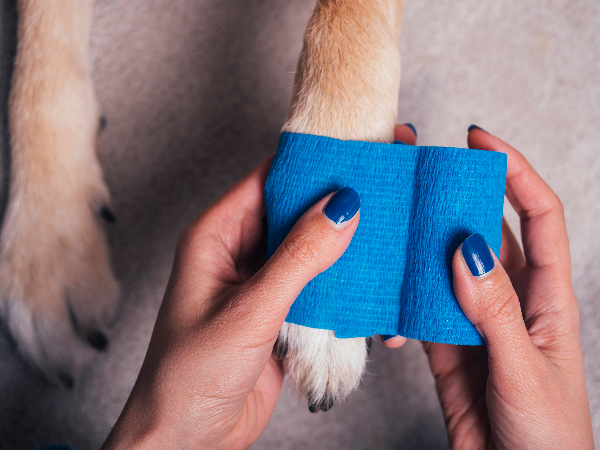Dog first aid kit. What should your dog first aid kit consist of?
We all love our dogs and naturally want to keep them safe. But accidents can happen — at home, on walks, even on holidays. That's where a dog first aid kit becomes essential.
We've put together this straightforward guide to help you assemble your dog first aid kit, meaning you’re fully prepared for any unexpected situations.
So what should your dog first aid kit consist of?
Emergency contact information
It's essential to have a list of emergency phone numbers, including your usual vet and the nearest 24-hour veterinary clinic. Including the number for a poison control helpline such as the Veterinary Poisons Information Service (VPIS) is also a good idea. This information can be crucial during an emergency when immediate veterinary assistance is required.
Bandages
Non-stick bandages or gauze are the best types to include in your dog's first aid kit, as they won't irritate your dog's fur. Use them to hold pressure on a bleeding injury or as a temporary wound cover until you can seek veterinary advice.
Please don't wrap the bandage too tight, but ensure it has enough pressure to stop the bleeding. If blood appears through an initial dressing, don’t remove it but put an additional bandage on top and seek urgent veterinary attention. Dressings should be changed every two days, but hopefully, by then, you will have already seen your vet.

Self-adhesive tape
The self-adhesive tape will be used to stop the bandage from unravelling. A little typically goes a long way. While self-adhesive tape is useful for securing dressings, it's essential to use a type that is safe for dogs. Regular adhesive tape may cause skin irritation or discomfort. Look for pet-specific adhesive tape that is gentle on your dog's skin.
Blunt-ended scissors
Blunt-ended scissors can cut bandages, cloth and dog fur around a wound. It's safer to use blunt-ended scissors instead of regular scissors to avoid accidental injury.
Wound wash
The best wound wash for dogs is saline solution. You can make your own saline solution by mixing approximately one teaspoon of salt or Epsom salts with 500ml (two cups) of hot water and stirring until dissolved. Wait for it to cool before using it on your dog at home, or use it cold out of a prepared bottle if out of the house. Dirty wounds are at risk of infection, so clean them as soon as you can, if your pet will tolerate it.
Cotton wool
Cotton wool should be stored in your first kit next to your wound wash. Dampen the cotton wool with the saline solution and gently wipe the affected area. This will help to clean it and stop infection.
Antiseptic wipes
Pet-safe antiseptic wipes can also be used in place of the saline solution. They can also be used to clean your dog off after any incidents, and keep tricky areas such as skin folds and around the back end clean if you’re away from your usual washing facilities.
Make sure you dispose of them properly when you're finished. Don't flush them.
Tweezers
Tweezers are invaluable for removing small thorns, splinters or anything too small to get with your fingers. Do not use tweezers to remove a tick from your dog. You can easily end up leaving the head in, leading to complications. Don’t remove any large objects, such as big shards of glass, as removal can lead to substantial bleeding. Seek urgent veterinary help in these circumstances.
Tick twister
If you find a tick on your dog, then the only tool you should use to remove it is a tick twister. It's a straightforward tool to use. Slide the prongs beneath the tick and gently but firmly twist and pull. This will ensure you get the whole tick out.
Flea and wormer
If you are going away and need to give your dog their monthly flea treatment, adding that to the first aid kit is a good idea. Remember, even missing one treatment can lead to a flea infestation.
Vinyl gloves
Gloves will help stop contamination when dealing with your dog's injury.
Foil blanket
Foil blankets provide excellent insulation and are superb at preventing hypothermia or shock during an emergency.
Muzzle or restraint device
Injured dogs may become frightened or agitated, increasing the risk of injury to themselves or those trying to help them. Including a muzzle or a suitable restraint device in your first aid kit can help ensure your and your dog's safety.
Thermometer and petroleum jelly
A rectal thermometer is an essential tool to check a dog's temperature in case of illness. Normal body temperature for dogs is between 38.3 to 39.2°C. Petroleum jelly can be used as a lubricant for the thermometer.
Torch
A small torch can be helpful for checking your dog's ears and throat or for looking more closely at wounds.
Towel or blanket
This can be used as a makeshift stretcher in case your dog is unable to walk, for padding or for warmth.
Why you need a first aid kit for your dog
Quick response to injuries
If your dog gets injured, whether a cut, bite or fall, having a first aid kit on hand can help you immediately care for them. It's essential if you can't get them to the vet directly. It can prevent the injury from worsening and potentially save your dog's life.
Emergency situations
If your dog is involved in an accident, whether a road traffic accident or an accident at the park, having a first aid kit can help you stabilise your dog until you can get them to a veterinary hospital.
Need more info?
A first aid kit can be a lifesaver, but it's not a substitute for professional veterinary care. If you need more advice on what to include or how to use any items, consult your nearest My Family Vets practice for practical, expert advice.
.jpg?ext=.jpg)



